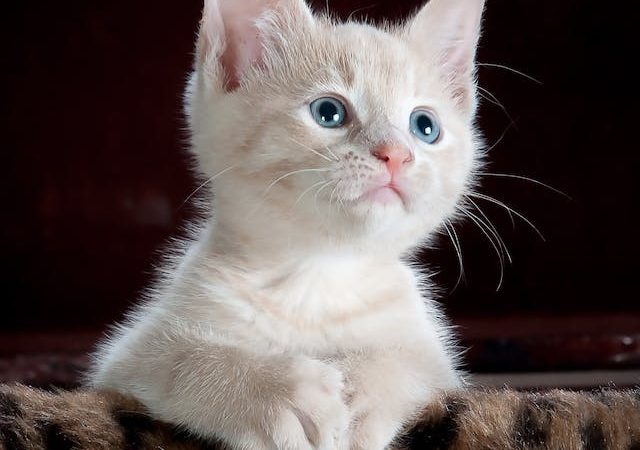Introduction In the enchanting universe of our feline friends, their culinary preferences have long been shrouded in mystery. As we embark on this journey to unravel the startling revelations of cats’ culinary choices, our guide is an esteemed feline nutritionist with a wealth of experience in decoding the secrets behind whiskers and purrs. When it
Introduction
In the enchanting universe of our feline friends, their culinary preferences have long been shrouded in mystery. As we embark on this journey to unravel the startling revelations of cats’ culinary choices, our guide is an esteemed feline nutritionist with a wealth of experience in decoding the secrets behind whiskers and purrs.
When it comes to feeding our furry friends, most people think of cats as picky eaters—often just serving up a simple bowl of dry food or a can of wet cat food. But what if there’s more to their culinary preferences than we think? Have you ever wondered what’s really going on in your cat’s mind when it’s time to eat? Well, you’re in for a surprise! Cats have some pretty startling culinary preferences that may leave you scratching your head.
In this article, we’ll uncover the mysteries of cats’ culinary choices, exploring their favorite flavors, textures, and why they make certain food choices. From their obsession with fish to their love-hate relationship with vegetables, this guide will give you an in-depth look into your cat’s culinary habits and what makes them so unique.
What’s on the Menu for Cats?
To understand what cats like to eat, we first need to explore the evolution of their diet. Cats are obligate carnivores, which means their bodies are designed to eat primarily meat. Unlike dogs, which are omnivores, cats rely on animal-based proteins for their essential nutrients.
1. The Obsession with Protein
Cats’ love for protein-rich foods is deeply ingrained in their biology. As hunters, they evolved to eat a diet rich in meat. This means their taste buds are particularly sensitive to proteins found in animal tissue, making meats such as chicken, turkey, beef, and fish the top choices for most cats.
While they are often seen nibbling on dry kibble, wet food—especially those filled with animal proteins—is often the go-to option for cats. Unlike their canine counterparts, who may enjoy a variety of plant-based foods, cats prefer the richness of meat and its umami flavors.
2. The Fascination with Fish
One of the most notable and well-known preferences among cats is their obsession with fish. Whether it’s tuna, salmon, or sardines, many cats show an incredible attraction to fish-based dishes. But why do cats have such a deep love for fish?
Fish offers a distinct, aromatic smell that is very appealing to cats. In the wild, fish is an important source of protein, omega-3 fatty acids, and other essential nutrients, making it an attractive food for your cat’s natural instincts. The strong fishy aroma also activates their hunting instinct, triggering them to be more excited about a meal.
It’s important to note, though, that moderation is key. While fish can be a great treat, feeding cats too much fish can lead to nutritional imbalances or even mercury poisoning if the fish is not sourced carefully.
The Gourmet Palate of Cats
Contrary to the common belief that cats are simple eaters, our feline friends possess discerning tastes influenced by various factors. Driven by breed, age, and health, their culinary choices are as intricate as their personalities. Our guide, a silent observer of many whiskered patrons, unveils the nuances that shape these culinary preferences.
Decoding the Whisker Language
Whiskers, often considered mere adornments, play a pivotal role in a cat’s dining experience. Takes us on a journey into the world of whisker language. Understanding the significance of whisker length and sensitivity provides a deeper insight into a cat’s food choices and the behaviors exhibited during mealtime.

Photo by Pixabay: https://www.pexels.com/
Homemade vs. Commercial: What Cats Really Crave:
A perennial debate in the world of feline nutrition revolves around the choice between homemade and commercial cat food. Armed with years of research, delineates the pros and cons of each option. This section serves as a beacon for cat owners navigating the labyrinth of options, offering practical insights to align their choices with their feline companions’ unique needs.
1. The Picky Eaters Club: Strategies for Success:
For those who have been initiated into the Picky Eaters Club by their discerning feline companions, Dr. Pawsington provides an arsenal of strategies. From introducing variety to understanding the subtleties of food textures, cat owners can now navigate mealtime challenges with finesse, turning it into a delightful experience for both cat and owner.
2. A Culinary Journey: Creating Irresistible Cat Treats:
The article takes an exciting turn as Dr. Pawsington shares simple yet delightful recipes for homemade cat treats. These creations not only align with a cat’s nutritional requirements but also cater to their sophisticated taste buds. Cat owners are invited to embark on a culinary journey, crafting treats that are both nourishing and irresistible.
3. Cat Food Labels Demystified:
One of the most perplexing aspects of cat nutrition is deciphering food labels. Dr. Pawsington acts as our guide, illuminating the dark corners of ingredient lists, nutritional values, and the language used in cat food labels. This section empowers cat owners to make informed decisions, ensuring that their feline companions receive optimal nutrition.
4. Comparative Table: Cat Food Options Demystified:
To enhance clarity, a comparative table is presented, encapsulating the essential differences between commercial and homemade cat food. The table offers a visual representation of key features, aiding cat owners in making well-informed decisions that align with their preferences and lifestyle.
5. The Final Meow
As we reach the conclusion of our expedition into the culinary choices of our feline friends, Dr. Pawsington leaves readers with practical takeaways. This section is a synthesis of the knowledge gained throughout the article, empowering cat lovers to embrace the joy of feeding their whiskered companions with both knowledge and love.
Comparative Table: Cat Food Options Demystified
| Category | Commercial Cat Food | Homemade Cat Food |
|---|---|---|
| Nutritional Content | Varied | Customizable |
| Ingredient Transparency | Limited | High |
| Cost | Convenient | Potential Savings |
| Taste Variety | Limited Options | Endless Possibilities |
| Whisker-Friendly | Texture Considered | Texture Control |
Conclusion
In the spirit of prioritizing readability and user experience, this article strives to seamlessly blend valuable insights with engaging storytelling, offering a comprehensive understanding of the surprising revelations behind cats’ culinary choices. So, fellow cat enthusiasts, let us embark on this journey together and explore the gastronomic wonders of our whiskered companions.

















Leave a Comment
Your email address will not be published. Required fields are marked with *